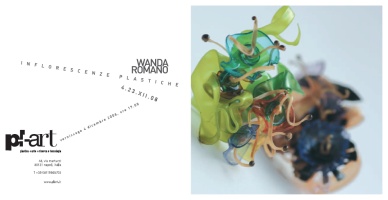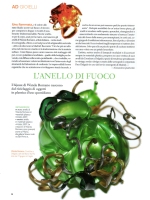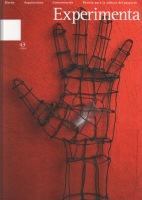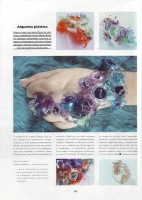 |
Solo show
Inflorescenze plastiche
from 4th to 23th December 2008
Museo Plart
via Martucci 48, Napoles, Italy
|
|
|
 |
AD
june 2008,
pag.38
|
L'anello di fuoco.
Una fiammata, e il colore allo stato fluido scorre sul banco di lavoro per comporsi in lingue e riccioli di esuberante tridimensionalità.
...
Alessandra Quattordio |
 |
 |
Experimenta
n.43,
May 2003,
page 34 |
Alquimia plástica.
Como si fuera una nueva Midas del reciclaje, la diseñadora italiana Wanda Romano consigue transformar plásticos de desecho contaminantes en joyas de formas naturales y motivos florales que contrastan con su sintética materia prima.
...
Vanessa Jiménez |
Jewelry created by Wanda Romano
Characteristics
| Colours: |
transparent, varied chromatic matching, use of superimposition, tone over tone, contrasts. |
| Shapes: |
floral modules with plastic coils and spirals and geometrical shapes. |
| Materials: |
PET and gold and silver thread. |
| Finished product: |
large piece of jewelry to be worn on the ring finger of the left hand with decorations on the back of the hand. |
Wanda Romano, Art teacher at the Liceo Italiano in Madrid, has been living and working in Spain since 1999.
Jewelry made with recyclable material. The project was launched five years ago as the result of systematic research on every-day materials. In this context, plastics are increasingly used for food containers and their recycling often creates an environmental hazard owing to the toxic fumes that plastics emanate when they are broken down. On the other hand, the extraordinary texture and colours of these materials prove to be of great aesthetic value.
From the extensive variety of plastics available in supermarkets. polythene or PET, used to manufacture bottles for mineral water and soft drinks, has been chosen for the jewelry. This choice is due to the material's transparency, colour and ease with which it is moulded. The research has been carried out through a process of search and cataloguing which has, as a result, shown the differences of availability among European Union countries (France, Italy, Spain, Belgium and the UK), as far as the colour, shape and texture of PET.
Italy has proven to have the most extensive colour range while in Spain one can find more unusual shapes such as that of the 5 litre bottle. The work with this material is related to the idea of a wearable jewel/sculpture (microsculpture), an object that dresses, as well as decorates hands. This light resistant material is ideal for creating large rings which are both comfortable to wear and of great aesthetic value. The plastic is reborn by changing its context and by reshaping it with skilled jewelry-making, cutting and assembly techniques. The newly-fashioned material is re-born, becoming a true piece of jewelry with exquisite chromatic nuances and transparencies which suggest technical delicacy and vitality as well as transmitting contrast and harmony. All these elements and characteristics lend the object a mysterious air. On a more deeply interpretative note, the object acquires not only aesthetic value but also conceptual value owing to the fact that it has been created from material which after its utility would normally have posed an environmental hazard. On the other hand, by renewing its life and turning it into an object of strong identity, the jewelry becomes precious as though it were made of high quality conventional materials. The floral motifs chosen to make the rings, were vaguely inspired by the Liberty style and this in turn refers to the concept of how a synthetic material can take on the shapes and colours of nature; leaves, flowers, spirals, lines which evoke water owing to their fluency of form and transparency. Colours, transparencies, chromatic superimpositions, nuances sought amongst the most harmonious of tones. The assembly of all these elements is executed by gauging colours and shapes for the left hand in order to make the object easier to wear. By superimposing plastic elements, certain tones allow changes of light and shape through their transparencies. Light and colour which are reminiscent of the transparencies and richness of Baroque Murano glassware. The apparent fragility of the pieces contrasts with the nature of the object itself, as indestructible as the material it is made of.
|
|
|
|
|